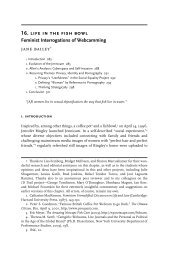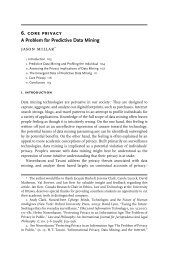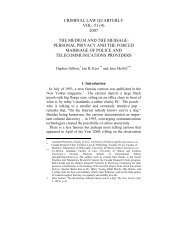Complete Cases Chart - Supreme Court of Canada - On the Identity ...
Complete Cases Chart - Supreme Court of Canada - On the Identity ...
Complete Cases Chart - Supreme Court of Canada - On the Identity ...
Create successful ePaper yourself
Turn your PDF publications into a flip-book with our unique Google optimized e-Paper software.
Case Name (<strong>Court</strong>)<br />
(Judge)<br />
Location/Method <strong>of</strong> Search Relevant Statutes Issues/Holdings<br />
- (1) whe<strong>the</strong>r <strong>the</strong> search violates s. 8 <strong>of</strong> <strong>the</strong>C<strong>Chart</strong>er? - Y/N<br />
- (2) whe<strong>the</strong>r to exclude evidence by s. 24(2)? – Y/N<br />
Reasoning<br />
- (1) relevant to s.8 + CASES (Kokesch, Plant, Hunter, Tessling, Edwards)<br />
- (2) relevant to 24(2) + CASES (Collins)<br />
information in an explosive situation where human life at risk; and it was not<br />
unreasonable for police to assume that neighbour had implied authority (from<br />
accused’s spouse) to grant access.<br />
- The law regarding s.8 violations on <strong>the</strong> basis <strong>of</strong> third-party consents is not well<br />
developed. Police action was characterized as a good faith mistake ra<strong>the</strong>r than a<br />
flagrant disregard for <strong>Chart</strong>er rights.<br />
- The <strong>of</strong>fence is serious - many police were required to ensure that lives were not<br />
endangered and evidence is needed to convict. Excluding evidence would have a<br />
more negative impact on administration <strong>of</strong> justice than admitting it.<br />
Pierre v. Pacific Press<br />
Ltd.<br />
1993 CanLII 577 (BC<br />
C.A.)<br />
Taylor J.A.;<br />
McEachern and Goldie<br />
JJ.A. (con).<br />
* Final Level (Leave<br />
to appeal dismissed<br />
by SCC)<br />
<strong>Identity</strong> – Records<br />
and Photographs<br />
R. v. Arason<br />
1992 CanLII 1008 (BC<br />
C.A.)<br />
Cumming J.A.;<br />
Proudfoot and Goldie<br />
JJ.A. (con).<br />
* Final Level<br />
Property Search –<br />
Business (perimeter<br />
search)<br />
-A woman undergoing<br />
treatment at rehabilitation<br />
centre claimed to have<br />
witnessed a murder.<br />
- Press interviewed and<br />
photographed her at <strong>the</strong><br />
centre and she subsequently<br />
asked a nurse to contact <strong>the</strong><br />
press to ask <strong>the</strong>m not to<br />
disclose her identity.<br />
- The press did disclose her<br />
identity (name and photos)<br />
and that she was a patient at<br />
<strong>the</strong> treatment centre while <strong>the</strong><br />
killers were still at large.<br />
- Police searched <strong>the</strong><br />
perimeter <strong>of</strong> a business<br />
premises, including <strong>the</strong> ro<strong>of</strong>.<br />
-The accused, who was<br />
inside, was not a lessee.<br />
-Police looked through <strong>the</strong><br />
mail box and detected <strong>the</strong><br />
smell <strong>of</strong> marijuana coming<br />
from an external vent.<br />
- The accused was observed<br />
visually and with binoculars.<br />
- Upon his arrest, <strong>the</strong><br />
- Crown Liability and<br />
Proceedings Act;<br />
-Privacy Act;<br />
-<strong>Chart</strong>er, s.2(b).<br />
- Narcotics Control Act<br />
and Criminal Code;<br />
- <strong>Chart</strong>er s.8, s.9, s.24(2).<br />
- The issues were technical ones concerning<br />
<strong>the</strong> trial judge’s decision to refuse a jury trial.<br />
The judge’s decision was based on <strong>the</strong> fact<br />
that:<br />
• <strong>the</strong> case involved novel issues <strong>of</strong> law that<br />
are <strong>of</strong> an ‘intricate and complex<br />
character’ (<strong>Supreme</strong> <strong>Court</strong> Rules) and<br />
thus not suitable for a jury trial; and<br />
• <strong>the</strong> CBC is immune from jury trials<br />
under Crown Liability and Proceedings<br />
Act.<br />
The <strong>Court</strong> <strong>of</strong> Appeal found insufficient<br />
arguments to resolve issues <strong>of</strong> law and set <strong>the</strong><br />
case down for fur<strong>the</strong>r hearing. It also found<br />
that <strong>the</strong> CBC not immune.<br />
- (1) Was <strong>the</strong> perimeter search a violation <strong>of</strong><br />
accuseds’ s.8 rights?<br />
• NO<br />
- (2) Was <strong>the</strong> vehicle search a violation <strong>of</strong> <strong>the</strong><br />
accuseds’ s.8 rights?<br />
• NO<br />
- (3) Should <strong>the</strong> evidence be excluded?<br />
- Ref. to Kokesch (boundaries <strong>of</strong> a perimeter search).<br />
- Ref. to Hunter (warrantless search is presumed to be unreasonable).<br />
- Although matter was not resolved, <strong>the</strong> following were issues raised and court’s<br />
response:<br />
• The plaintiff’s claims concern <strong>the</strong> infliction <strong>of</strong> psychological injury (she worried<br />
for her safety as perpetrators were at large) and violating <strong>the</strong> Privacy Act (tort <strong>of</strong><br />
violation <strong>of</strong> privacy).<br />
• The defendant claims that s.2(b) <strong>of</strong> <strong>Chart</strong>er (freedom <strong>of</strong> <strong>the</strong> press) answers a<br />
claim in negligence and under <strong>the</strong> Privacy Act. The court found that journalists<br />
have no special privilege re publishing things that may be harmful and also found<br />
that <strong>the</strong> <strong>Chart</strong>er is no answer under Privacy Act unless <strong>the</strong>re is consent. It is a<br />
question <strong>of</strong> law whe<strong>the</strong>r <strong>the</strong>re was a reasonable expectation <strong>of</strong> privacy in <strong>the</strong><br />
ga<strong>the</strong>ring <strong>of</strong> information by <strong>the</strong> press.<br />
- (1) The accused had no standing to bring a <strong>Chart</strong>er infringement complaint<br />
because <strong>the</strong>y were not <strong>the</strong> ‘occupants’ <strong>of</strong> <strong>the</strong> premises in that <strong>the</strong>y were not lessees<br />
or owners. Even if <strong>the</strong>y were ‘occupants’, <strong>the</strong>re is no reasonable expectation <strong>of</strong><br />
privacy with regard to <strong>the</strong> perimeter <strong>of</strong> a commercial premises since <strong>the</strong> exterior<br />
and <strong>the</strong> parking lot are generally accessible to <strong>the</strong> public. According to <strong>the</strong> terms <strong>of</strong><br />
<strong>the</strong> lease, even tenants had no right <strong>of</strong> control <strong>of</strong> <strong>the</strong> exterior <strong>of</strong> <strong>the</strong> building,<br />
including <strong>the</strong> ro<strong>of</strong>. Looking through <strong>the</strong> mail box may have been improper, but<br />
nothing seen was used.<br />
- (2) There were reasonable and probable grounds for <strong>the</strong> arrest and search;<br />
<strong>the</strong>refore <strong>the</strong> unwarranted arrest and search were not unlawful. The applicable test<br />
is from Storrey (SCC): “An arrest without warrant may be made where <strong>the</strong> <strong>of</strong>ficer<br />
43







